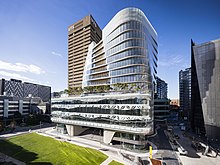UTS: Voice to Parliament helps Indigenous Nation Building
Prime Minister Anthony Albanese has announced the wording of the referendum question to enable a constitutionally enshrined Indigenous Voice to Parliament. It would seem Albanese has made a solid start on his election night promise to embrace the 2017 Uluru Statement from the Heart.
As Albanese put it at Garma Festival over the weekend:
The Uluru Statement is a hand outstretched, a moving show of faith in Australian decency and Australian fairness from people who have been given every reason to forsake their hope in both.
At its core, the Uluru Statement is an invitation to Australia to establish a new relationship with Aboriginal and Torres Strait Islander peoples. It is also an opportunity for First Nations to nation-build alongside the Australian people and its government.
An Indigenous Nation Building approach involves a shift in the mindset of First Nations peoples and non-Indigenous people. Rather than looking at what settler governments can do for First Nations peoples, the question becomes: how can we as First Nations people build our own capacity? If it aligns with our aspirations, how can we use their settler-colonial government policies for our own benefit?
What did the Uluru Statement ask for?
The statement acknowledges an intertwined relationship between “Australia’s nationhood” and the existence of First Nations:
With substantive constitutional change and structural reform, we believe (our) ancient sovereignty can shine through as a fuller expression of Australia’s nationhood.
However, the statement is also explicit about First Nations sovereignty, which “has never been extinguished”, and Indigenous nationhood:
Our Aboriginal and Torres Strait Islander tribes were the first sovereign Nations of the Australian continent and its adjacent lands, and possessed it under our own laws and customs.
The most effective way for governments to acknowledge and respect Indigenous nationhood would be to pursue structural reform that facilitates First Nations self-determination and self-government. An Indigenous Voice to Parliament may be one step towards this goal.
So far, First Nations peoples have largely been represented through issues-based initiatives such as the National Partnership Agreement on Closing the Gap. However, if Labor engages with the many Indigenous nations across this continent, a Voice to Parliament could better ensure cultural and political representation.
Minister for Indigenous Australians Linda Burney has encouraged Australians to see the Uluru Statement, and an Indigenous Voice to Parliament, as a “nation building project”.
She is right. However, both settler governments and Indigenous peoples should be encouraged to see this development not just as an opportunity for Australian “nation building”, but as a chance to rebuild Indigenous nations after the impacts of colonisation on their societies, law, culture and Country.
What is Indigenous Nation Building?
Indigenous Nation Building describes First Nations strengthening their capacity for effective self-government and self-determined community and economic development.
It requires First Nations peoples having long-term, decision-making control over their nation’s affairs. It is achieved through effective and culturally appropriate self-government institutions, whether these are newly established or revitalised.
How can governments and First Nations achieve this?
We are Indigenous Nation Building practitioners and researchers who have been exploring what works over many years.
Based on this experience, the evidence, and recent conversations with First Nations leaders and researchers, we have two key pieces of advice for Australian governments and First Nations as they seek to embark on this new journey:
If an Indigenous Voice to Parliament and other policies are to be successful and sustainable, governments need to engage with Indigenous nations as well as other Indigenous organisations
Indigenous peoples’ collective aspirations can align with the Australian government’s commitment to a Voice to Parliament. First Nations peoples have been let down by governments many times before. But some nations are using policy for their own purposes. One example is the Gunditjmara People’s decision to pursue a World Heritage Listing for the Budj Bim Cultural Landscape. This would gain protection of their Country alongside recognition of their authority for it.
First Nations need to use any developments, including a Voice to Parliament, as an opportunity for their own nation building.
If Indigenous Nation Building is embraced by Australian governments and First Nations, there is an opportunity for real change, as envisaged by Indigenous nations for generations and reaffirmed in the Uluru Statement from the Heart.The Conversation

